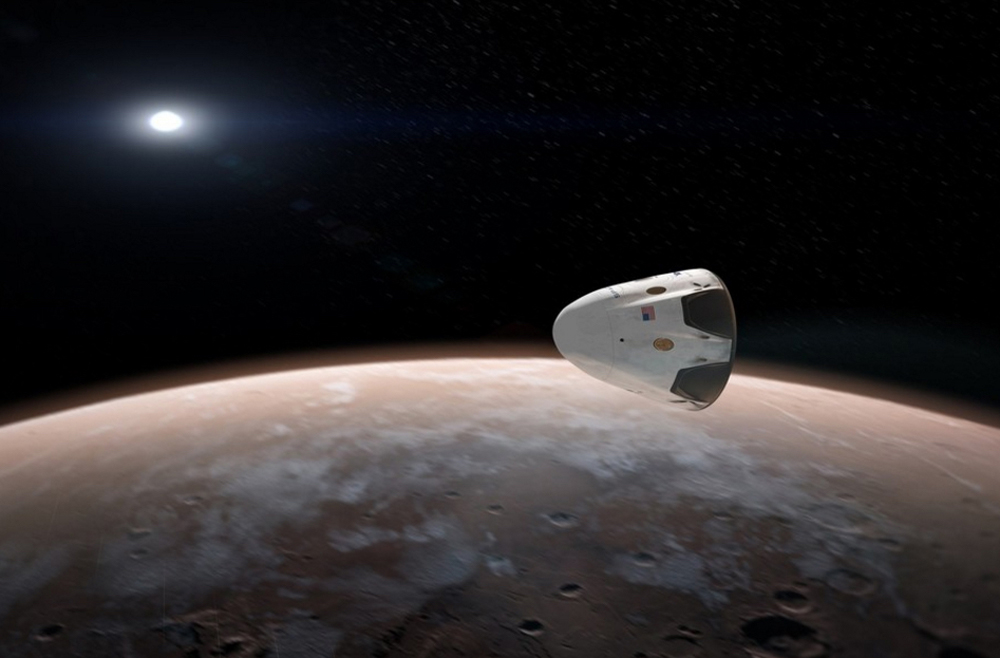NASA: Odds Favor Successful SpaceX Mars Mission

Before NASA decided to help SpaceX on its journey to Mars, details of which company chief Elon Musk plans to unveil on Tuesday, the U.S. space agency reviewed the plan for SpaceX's first mission, slated to launch in 2018, and decided it has a reasonably good chance of success.
For NASA, a successful mission means that SpaceX's Mars vehicle, called Red Dragon, flies through the Martian atmosphere with its thrusters firing in the direction of travel, a technology known as supersonic retrograde propulsion. The feather in the cap would be a propulsive landing on the Martian surface.
"This is a critical, critical technology for us," said Phil McAlister, director of NASA's Commercial Spaceflight Division. "This is flight data that would not be available to us by any other means."
RELATED: Musk: SpaceX Will Go 'Well Beyond' Mars
NASA is working toward sending astronauts to Mars in the mid-2030s. Musk aims to beat that by a decade.
The tech entrepreneur, who also heads Tesla Motors, is scheduled to unveil details of his Mars initiative during a presentation on Tuesday at the International Astronautical Congress in Guadalajara, Mexico.
SpaceX's debut mission is well into the planning stages. The company hopes to launch an unmanned Dragon capsule aboard a heavy-lift Falcon rocket in 2018, the next time the orbits of Earth and Mars are favorably aligned for flight.
Get the Space.com Newsletter
Breaking space news, the latest updates on rocket launches, skywatching events and more!
After traveling for about 180 days, Red Dragon would enter Mars' thin atmosphere and make a powered descent and landing on the surface.
RELATED: Musk: SpaceX to Launch People to Mars in 8 Years
Dragon is too small to have passengers aboard, but it would become the biggest spacecraft ever to land on Mars.
NASA wants to be able to land 20- to 30 tons on Mars at a time. So far, the heaviest payload to land was the one-ton Curiosity rover.
WATCH VIDEO: Who Will Win the Race to Mars?
"The primary mission objective is to learn how to get to and land on Mars. If they do that -- just that -- this would be a huge success for SpaceX," McAlister said during a teleconference presentation to the NASA Future In-Space Operations group on Wednesday.
The Red Dragon mission "offers a flight demo of critical EDL (entry, descent and landing) technology -- particularly the supersonic retrograde propulsion -- probably at least a decade sooner and at a small fraction of the cost to NASA that it would be if we did our own kind of mission to get this data," McAlister added.
"We don't even have a mission on the books, so it's not even clear how long it would take. This is a very cost-effective way for us to get this kind of data … a key first step," he said.
RELATED: Red Dragon: SpaceX Targets 2018 for First Mars Mission
SpaceX intends to ramp up its expertise on Mars travel and operations with missions each time Earth and Mars favorably align for launch, which occurs about every 26 months.
In exchange for flight data and other information, NASA is serving as consultant and technical advisor for the Red Dragon mission. The agency also will let SpaceX use its deep-space and Mars relay communications networks. Red Dragon also may carry some NASA-sponsored payloads.
"SpaceX is responsible for and is going to maintain control over the Red Dragon, design, hardware and operations all the way through flight and post-flight," McAlister said.
"We determined that there was a reasonable likelihood of success for this mission that would be increased with our participation," he added. "Even if it's not successful, we felt our participation would be worthwhile."
Originally published on Discovery News.
Join our Space Forums to keep talking space on the latest missions, night sky and more! And if you have a news tip, correction or comment, let us know at: community@space.com.

Irene Klotz is a founding member and long-time contributor to Space.com. She concurrently spent 25 years as a wire service reporter and freelance writer, specializing in space exploration, planetary science, astronomy and the search for life beyond Earth. A graduate of Northwestern University, Irene currently serves as Space Editor for Aviation Week & Space Technology.









